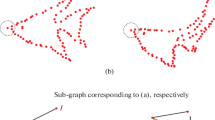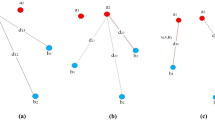Abstract
The non-rigid registration methods, such as coherent point drift (CPD) method can deal with similar point sets, but it is difficult for them to achieve the non-rigid registration of point sets with large deformations. To overcome the problem, a novel approach via building dynamic tree is proposed in this paper. First of all, the similarity between the model and subject point sets is evaluated by the affine iterative closest point (ICP) algorithm with bidirectional distance, and the models and their similar subjects are connected. Secondly, the non-rigid registration is conducted on every two similar point sets. The subjects with accurate registration results are added to the model sets and wrong pairs are cut off based on a bidirectional distance. These steps are repeated and a dynamic tree is built up. In this way, a large deformation between two images is decomposed into a series of small deformations and the elimination of the wrong pairs in the dynamic tree guarantees the registration results are precise and satisfactory. Experimental results on several image datasets demonstrate that our method improves the accuracy of the point set registration results with large shape difference compared with existing approaches.








Similar content being viewed by others
References
Amberg, B., Romdhani, S., Vetter, T. (2007). Optimal step nonrigid ICP algorithms for surface registration. In: Proceedings of IEEE Conference on Computer Vision and Pattern Recognition (CVPR), pp. 1–8
Barber CB, Dobkin DP, Huhdanpaa H (1996) The quickhull algorithm for convex hulls. ACM Transactions on Mathematical Software (TOMS) 22(4):469–483
Besl PJ, Mckay HD (1992) A method for registration of 3-D shapes. IEEE Trans Pattern Anal Mach Intell 14:239–256
Chen, Y., Medioni, G. (1991). Object modeling by registration of multiple range images. In: Proceedings of Proceedings of IEEE conference on Robotics and Automations, pp. 2724–2729
Chetverikov D, Stepanov D, Krsek P (2005) Robust Euclidean alignment of 3D point sets: the trimmed iterative closest point algorithm. Image Vis Comput 23(3):299–309
Chui H, Rangarajan A (2003) A new point matching algorithm for non-rigid registration. Comput Vis Image Underst 89(2):114–141
Du S, Zheng N, Ying S, Liu J (2010) Affine iterative closest point algorithm for point set registration. Pattern Recogn Lett 31(9):791–799
Du S, Liu J, Zhang C, Xu M, Xue J (2015) Accurate non-rigid registration based on heuristic tree for registering point sets with large deformation. Neurocomputing 168:681–689
Gao Y, Wang M, Tao D, Ji R, Dai Q (2012) 3-d object retrieval and recognition with hypergraph analysis. IEEE Trans Image Process 21(9):4290–4303
Gao Y, Ji R, Cui P, Dai Q, Hua G (2014) Hyperspectral image classification through bilayer graph-based learning. IEEE Trans Image Process 23(7):2769–2778
Granger, S., Pennec, X. (2002). Multi-scale EM-ICP: A fast and robust approach for surface registration. In: Proceedings of European Conference on Computer Vision (ECCV), pp. 418–432
Greenspan, M., Yurick, M. (2003). Approximate k-d tree search for efficient ICP. In: Proceedings of Fourth International Conference on 3-D Digital Imaging and Modeling (3DIM), pp. 442–448
Jia H, Yap P, Shen D (2012) Iterative multi-atlas-based multi-image segmentation with tree-based registration. NeuroImage 59(1):422–430
Jian, B., Vemuri, B.C. (2005). A robust algorithm for point set registration using mixture of Gaussians. In: Proceedings of Tenth IEEE International Conference on Computer Vision (ICCV), pp. 1246–1251
Liu M, Zhang D, Shen D (2015) View-centralized multi-atlas classification for Alzheimer’s disease diagnosis. Hum Brain Mapp 36(5):1847–1865
Liu M, Zhang D, Shen D (2016) Relationship induced multi-template learning for diagnosis of Alzheimer’s disease and mild cognitive impairment. IEEE Trans Med Imaging 35:1463–1474
Mokhtarian F, Abbasi S, Kittler J (1996) Robust and efficient shape indexing through curvature scale space. In: Proceedings of British Machine Vision Conference (BMVC), pp 53–62
Mokhtarian F, Abbasi S, Kittler J (1997) Efficient and robust retrieval by shape content through curvature scale space. Series on software engineering and knowledge. Engineering 8:51–58
Myronenko A, Song X (2010) Point set registration: coherent point drift. IEEE Trans Pattern Anal Mach Intell 32(12):2262–2275
Nüchter, A., Lingemann, K., Hertzberg, J. (2007). Cached k-d tree search for ICP algorithms. In: Proceedings of Sixth International Conference on 3-D Digital Imaging and Modeling (3DIM), pp. 419–426.
Phillips, J.M., Ran, L., Tomasi, C. (2007). Outlier robust ICP for minimizing fractional RMSD. In: Proceedings of Sixth International Conference on 3-D Digital Imaging and Modeling (3DIM), pp. 427–434
Wolz R, Aljabar P, Hajnal JV, Hammers A, Rueckert D, Initiative ADN (2010) LEAP: learning embeddings for atlas propagation. NeuroImage 49(2):1316–1325
Ying S, Peng J, Du S, Qiao H (2009) A scale stretch method based on ICP for 3D data registration. IEEE Trans Autom Sci Eng 6(3):559–565
Ying S, Wu G, Wang Q, Shen D (2014) Hierarchical unbiased graph shrinkage (HUGS): a novel groupwise registration for large data set. NeuroImage 84:626–638
Zhang Z (1994) Iterative point matching for registration of free-form curves and surfaces. Int J Comput Vis 13(2):119–152
Zhang J, Liang J, Zhao H (2013) Local energy pattern for texture classification using self-adaptive quantization thresholds. IEEE Trans Image Process 22(1):31–42
Zhang J, Gao Y, Gao Y, Munsell B, Shen D (2016) Detecting anatomical landmarks for fast Alzheimer’s disease diagnosis. IEEE Transactions on Medical Imaging. doi:10.1109/TMI.2016.2582386
Acknowledgments
This work was supported by the National Natural Science Foundation of China under Grant No. 61573274, and the Program of Introducing Talents of Discipline to University under Grant No. B13043.
Author information
Authors and Affiliations
Corresponding author
Rights and permissions
About this article
Cite this article
Du, S., Bi, B., Xu, G. et al. Robust non-rigid point set registration via building tree dynamically. Multimed Tools Appl 76, 12065–12081 (2017). https://doi.org/10.1007/s11042-016-4018-6
Received:
Revised:
Accepted:
Published:
Issue Date:
DOI: https://doi.org/10.1007/s11042-016-4018-6




